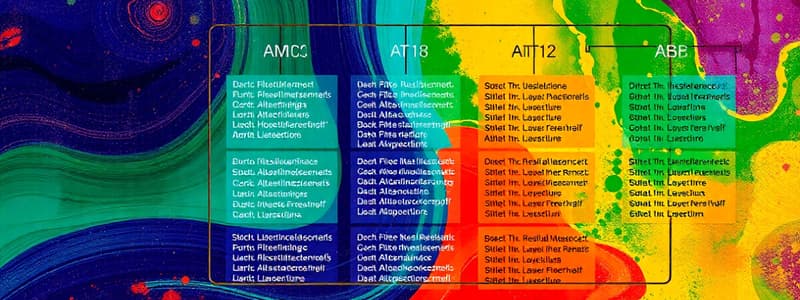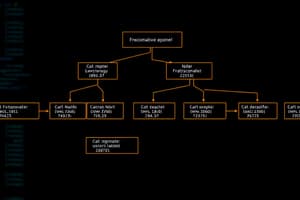Podcast
Questions and Answers
In the context of relational databases, what is the primary function of predicate logic?
In the context of relational databases, what is the primary function of predicate logic?
- To ensure data consistency over time.
- To provide a framework for verifying statements of fact as true or false. (correct)
- To define the physical storage structure of data.
- To manipulate sets of data using mathematical operations.
Which component is NOT a part of the relational model?
Which component is NOT a part of the relational model?
- A set of operations that defines how data is manipulated
- A set of integrity rules.
- A set of procedural operations that directly modify data storage. (correct)
- A logical data structure represented by relations.
What does the term 'attribute domain' refer to in the context of a relational database?
What does the term 'attribute domain' refer to in the context of a relational database?
- The unique identifier for each row in a table.
- The method of data manipulation within a table.
- The specific range of values allowed for each column. (correct)
- The physical location where the database is stored.
Why is STU_NUM a better choice for a primary key than STU_LNAME in a student database?
Why is STU_NUM a better choice for a primary key than STU_LNAME in a student database?
What does 'determination' mean in the context of database keys?
What does 'determination' mean in the context of database keys?
Given the functional dependency STU_NUM → (STU_LNAME, STU_FNAME, STU_MI, STU_SECT), what does this indicate?
Given the functional dependency STU_NUM → (STU_LNAME, STU_FNAME, STU_MI, STU_SECT), what does this indicate?
What is a 'composite key' in database terminology?
What is a 'composite key' in database terminology?
How does a 'superkey' differ from a 'candidate key'?
How does a 'superkey' differ from a 'candidate key'?
What is the primary role of a 'foreign key' in a relational database?
What is the primary role of a 'foreign key' in a relational database?
What is the entity integrity rule in relational databases?
What is the entity integrity rule in relational databases?
What does referential integrity ensure in the context of relational databases?
What does referential integrity ensure in the context of relational databases?
In the context of integrity rules, what is the significance of allowing a foreign key to have a NULL entry?
In the context of integrity rules, what is the significance of allowing a foreign key to have a NULL entry?
What is the purpose of using 'flags' in database design, as mentioned in the text?
What is the purpose of using 'flags' in database design, as mentioned in the text?
What is the significance of 'closure' in relational algebra?
What is the significance of 'closure' in relational algebra?
Among the fundamental relational algebra operations, which one is used to retrieve a subset of columns from a table?
Among the fundamental relational algebra operations, which one is used to retrieve a subset of columns from a table?
What is the purpose of the SELECT relational algebra operator?
What is the purpose of the SELECT relational algebra operator?
Which relational algebra operation combines the rows from two tables into a new table, removing any duplicate rows??
Which relational algebra operation combines the rows from two tables into a new table, removing any duplicate rows??
What does the PRODUCT operation (Cartesian Product) do in relational algebra?
What does the PRODUCT operation (Cartesian Product) do in relational algebra?
What is the main purpose of the JOIN operation in relational algebra?
What is the main purpose of the JOIN operation in relational algebra?
What does it mean for two tables to be 'union-compatible'?
What does it mean for two tables to be 'union-compatible'?
Flashcards
Table (Relation)
Table (Relation)
A two-dimensional structure composed of rows and columns. Each row represents data about an entity and each column represents an attribute.
Key
Key
An attribute or group of attributes that determines the values of other attributes.
Determination
Determination
The state in which knowing the value of one attribute makes it possible to determine the value of another.
Functional Dependence
Functional Dependence
Signup and view all the flashcards
Determinant (Key)
Determinant (Key)
Signup and view all the flashcards
Dependent
Dependent
Signup and view all the flashcards
Composite Key
Composite Key
Signup and view all the flashcards
Key Attribute
Key Attribute
Signup and view all the flashcards
Superkey
Superkey
Signup and view all the flashcards
Candidate Key
Candidate Key
Signup and view all the flashcards
Primary Key
Primary Key
Signup and view all the flashcards
Foreign Key
Foreign Key
Signup and view all the flashcards
Secondary Key
Secondary Key
Signup and view all the flashcards
Entity Integrity
Entity Integrity
Signup and view all the flashcards
Referential Integrity
Referential Integrity
Signup and view all the flashcards
Relational Algebra
Relational Algebra
Signup and view all the flashcards
Union-Compatible
Union-Compatible
Signup and view all the flashcards
SELECT (Relational Algebra)
SELECT (Relational Algebra)
Signup and view all the flashcards
PROJECT (Relational Algebra)
PROJECT (Relational Algebra)
Signup and view all the flashcards
UNION (Relational algebra)
UNION (Relational algebra)
Signup and view all the flashcards
Study Notes
- The relational model, introduced in 1970 by E. F. Codd, is based on predicate logic and set theory.
Fundamentals
- Predicate logic provides a framework to verify assertions (statements of fact) as true or false; for example, a student with ID 324452 is Mark Reyes.
- Set theory deals with sets or groups and is the basis for data manipulation; for example, sets A (15, 23, 52) and B (41, 52, 70, 12) share the value 52.
- The relational model has three components: a logical data structure (relations), integrity rules, and a set of operations.
- A table (relation) is a two-dimensional structure of rows and columns.
- Each table row (tuple) represents data about an entity.
- Each table column represents an attribute with a distinct name.
- Each row and column intersection represents a single data value.
- Column values must conform to the same data format, with a specific range known as the attribute domain.
- The order of rows and columns is not important in a DBMS.
Student Table Conclusions
- The STUDENT table is composed of six rows/tuples and five columns/attributes.
- Each row describes a student; for example, row 5 describes Martin S. Cruz.
- STU_MI values are limited to characters A to Z, representing the domain [A, Z].
- STU_NUM is the primary key, guaranteed unique for each student.
- STU_LNAME is not a good primary key because students can share the same last name.
Keys
- A key is an attribute or group determining other attribute values; an invoice number identifies invoice attributes like date and customer name.
- Determination is when an attribute's value makes it possible to determine another's value, based on relationships among attributes.
- Functional dependence means one or more attributes' values determine others' values.
- The determinant or key is the attribute whose value determines another attribute, called the dependent.
- Standard notation for representing relationships between attributes is ATT_A → ATT_B; for example, STU_NUM → STU_LNAME.
- STU_NUM is the determinant, and STU_LNAME is the dependent; a STU_NUM value determines the STU_LNAME since only one value is associated with any given STU_NUM.
- Functional dependence can involve a determinant that comprises multiple attributes, example STU_NUM → (STU_LNAME, STU_FNAME, STU_MI, STU_SECT).
- A composite key is composed of more than one attribute.
- A key attribute is part of a key.
Key Types
- A superkey uniquely identifies rows; such as STU_NUM, or (STU_NUM, STU_LNAME).
- A candidate key is a superkey without unnecessary attributes; STU_NUM.
- A primary key is a candidate key to uniquely identify all attribute values in a row and cannot contain null entries; STU_NUM.
- A foreign key matches the primary key in another table or can be null; STU_SECT can be a foreign key if used as a primary key of another table.
- A secondary key is used strictly for data retrieval; such as (STU_LNAME, STU_FNAME, STU_MI).
Integrity Rules
- Entity integrity is when each table row has a unique identity.
- Referential integrity is when every reference to an entity instance by another entity instance is valid.
- Integrity rules are followed to maintain database design.
Entity Integrity
- Requirement: Primary key entries are unique and non-null.
- Purpose: Rows have unique identity, and foreign keys properly reference primary key values.
- Example: An invoice has a unique non-null number.
Referential Integrity
- Requirement: Foreign keys may be null as long as they are not part of the table's primary key, or an entry that matches the related table's primary key.
- Every non-null foreign key value must reference an existing primary key value.
- It is possible for an attribute to not have a value but impossible to have an invalid entry.
- The enforcement of referential integrity prevents deleting a row with mandatory matching foreign key values in another table.
- A customer might not yet have assigned sales representative number, but it will be impossible to have an invalid representative number.
Table Features
- Entity Integrity: The STUDENTS primary key (STU_NUM) column has no null entries, and all entries are unique.
- The SECTIONS table's primary key is STU_SECT, this column is also free of null entries.
- Referential Integrity: The STUDENTS table contains a foreign key, STU_SECT, that links entries in it to entries in the SECTIONS table.
- To avoid null values, special codes called flags are used, such as NS in the STU_SECT entry, to indicate that Marco Velasco's section does not yet have an assigned code.
Relational Algebra
- Data can be manipulated to generate useful information.
- Relational algebra manipulates relation contents, and when used on existing relations (tables) produce new relations called closure.
- The condition to be evaluated is also known as predicate.
- The eight fundamental relational operators are SELECT, PROJECT, UNION, INTERSECT, DIFFERENCE, PRODUCT, JOIN, DIVIDE.
Relational Algebra Operators
- SELECT retrieves a subset of rows: σ CONDITION (TABLE).
- PROJECT retrieves a subset of columns: π COLUMNS (TABLE).
- UNION merges union-compatible tables, dropping duplicate rows: TABLE1 ∪ TABLE2
- INTERSECT returns rows common to two union-compatible tables: TABLE1 ∩ TABLE2.
- DIFFERENCE retrieves rows not found in another union-compatible table: TABLE1 – TABLE2.
- PRODUCT retrieves possible row pairs; Cartesian Product: TABLE1 x TABLE2.
- JOIN retrieves rows based on criteria: TABLE1 ⨝ TABLE2.
- DIVIDE retrieves values: TABLE1 ÷ TABLE2.
Studying That Suits You
Use AI to generate personalized quizzes and flashcards to suit your learning preferences.




